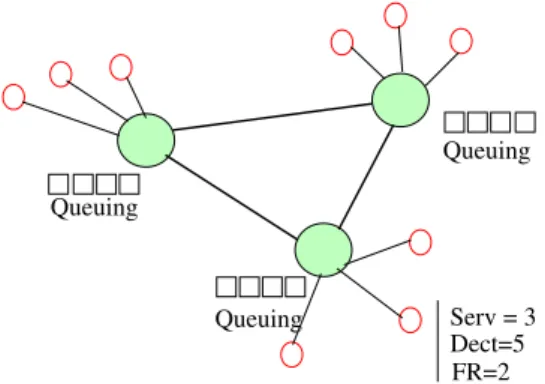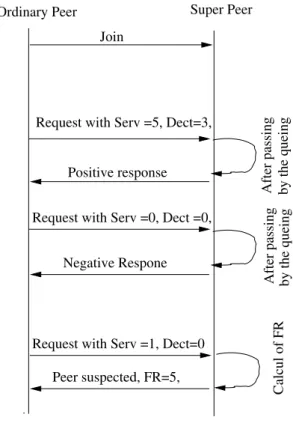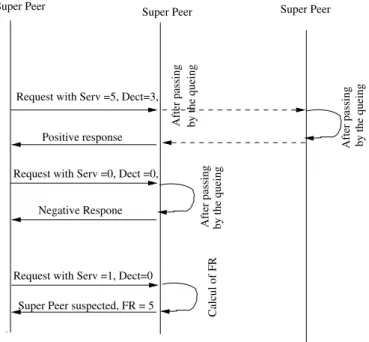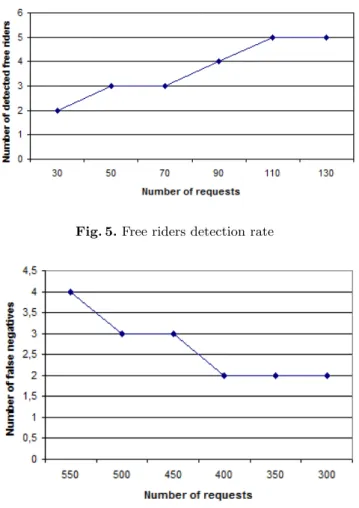Riding Problem in Peer to Peer Networks
Mourad Amad1, Djamil A¨ıssani1, Ahmed Meddahi2, and Abdelmalek Boudries3 1 Laboratory LAMOS, University of Bejaia, Algeria amad.mourad@gmail.com, lamos bejaia@hotmail.com
2 Telecom Lille 1, France ahmed.meddahi@telecom-lille1.eu
3 University of Bejaia, Algeria abdelmalek.boudries@yahoo.fr
Abstract. Peer-to-Peer (P2P) systems are increasingly popular as an alternative to the traditional client-server model for many applications, particularly file sharing. Free-riding is one of the most serious problems encountered in Peer-to-peer (P2P) systems like BitTorrent.
Free riding is a serious problem in P2P networks for both Internet service providers (ISPs) and users. To users, the response time of query increases significantly because a few altruistic peers have to handle too many requests. In P2P file sharing systems, free-riders who use oth-ers’ resources without sharing their own cause system-wide performance degradation. Therefore, the rational P2P application developers should develop some anti-free riding measures to deal with it.
In this paper, we propose a pragmatic and scalable peer to peer scheme based on a utility function that uses two parameters: collaboration of peers and detection of tentative of free riders. Performance evaluation of the proposed solution shows that results are globally satisfactory. Keywords: Free riding, Free rider, Peer-to-Peer (P2P) network, Utility function.
1
Introduction
The decentralized peer-to-peer model (P2P) of communication has emerged as a viable alternative to the traditional client server based centralized model in the large scale distributed systems. There are mainly three P2P architectures: centralized, decentralized and hybrid. The first architecture distributes the stor-age services but the resource search process is already centralized in like server. Napster is a representative example of such system. The second architecture is divided on two types; structured and unstructured architecture. Decentralized structured architecture such as HPM [2] is cost effective in terms of routing
(op-timized and greedy). However, the semantic aspect and the maintenance cost are
not well considered. Decentralized unstructured architecture is opposite to the A. Amine et al. (Eds.): Modeling Approaches and Algorithms, SCI 488, pp. 135–144.
former one, the lookup service is not greedy (flooding or probabilistic). However, the topology maintenance and the semantic search are well considered. As an example of theses architectures, we can cote: Gnutella . The later architecture (hybrid) consists of a set of super peers organized in decentralized architec-ture (strucarchitec-tured or unstrucarchitec-tured ). Each super peer manages a small network in centralized manner such as in Napster. KaZaad and Skype are representative examples of this architecture.
P2P networks are confronted to many problems: routing performance, seman-tic search, security aspect, firewall detection and traversal, anonymity of users, free riding, network management performance, etc. In this paper, we study the free riding problem. Free riding means exploiting P2P network resources (through
searching, downloading objects, or using services) without contributing to the
P2P network at desirable levels.
Free-riding problem is not just observed in P2P systems. This type of rational behavior also appears in the context of strategic network formation, selfish rout-ing, mobile ad hoc networks and congestion control. However, the prevalence of free-riding behavior in P2P systems can be attribute d to some specific charac-teristics, including decentralization, high churn rate (users dynamically joining
and leaving the system), availability of cheap identities (pseudonyms), hidden
actions (e.g. nodes not forwarding messages to reduce computing and
commu-nication cost ), and collusion (users forming groups to maximize benefit ) [9]. In
other words, free rider peers in P2P networks are already high consumers, and low or never producers.
Within a short time of its release, the Gnutella network found about 75% of its users free-riding, i.e., downloading files from the network without uploading any content [1]. In the same study, they found that only 10% of peers provide almost 90 % of services in the P2P network. Most peers share no more than ten files or some unpopular files, which are not queried or downloaded by others at all [1].
Many proposed free riding solutions have been proposed in the literature. However, most of them are much cost in terms of implementation or suffer from the scalability problem. In this paper, we try to give a new solution to free riding problem in P2P networks, considering both cited obstacles.
The rest of this paper is organized as follow: next section gives a brief overview of peer to peer networks and related works on free riding in such networks. In section 3, we introduce our proposed model to reduce and isolate the free rider peers from our network. The proposed solution is programmatic and scalable. Performance evaluation of the proposed solution is illustrated in section 4. Fi-nally, we conclude and give some perspectives for future works.
2
Background and Related Works
In this section, we give a background on P2P networks, and then we explain the most important solutions that have been given to address the free riding problem in such networks.
2.1 Background on P2P Networks
It is widely believed that the success of P2P file sharing systems depends upon the quality of service (QoS ) offered by such systems. Many types of applications are investigated by P2P technology such as: file sharing, parallel and distributed computing, collaboration and communication and recently Internet telephony. However, file sharing applications are the most used. Many studies show that the most important part of Internet flows are from P2P file sharing applications. Hybrid P2P architecture is well adapted to file sharing applications. The main-tenance cost is reduced and the scalability is considered. However, mobility and time connectivity of super peers are a challenge. In general, we choose peer with low mobility and long time connectivity as a super peer.
For our proposed model against free riding problem, we use the hybrid P2P architecture represented on Figure 1 as administration and interconnexion ar-chitecture. In this architecture, we distinguish two types of peers: ordinary peer and super peer. Each set of ordinary peers is managed by a super peer. This later is principally characterized by high speed, long time connectivity and high storage capability.
Super peer Ordinary peer
Fig. 1. Hybrid P2P architecture
Each peer (ordinary peer or super peer ) shares their own resources and can search or request other resources. Ordinary node searches resources by asking its super peer. Super peer searches resources by asking its neighboring peers. Peer that searches resources and does not offering is called free rider.
2.2 Related Works on Free Riding
A number of solutions have been proposed to address the free-riding problem in peer-to-peer systems, particularly for file sharing applications or streaming appli-cations [8]. The authors of [3] propose to introduce a utility function to capture contributions made by a user and an auditing scheme to ensure the integrity of
a utility function’s values. The principal problem of this solution is the choice of the utility function. In [7], Give-to-get algorithm has been proposed; it encour-ages peers to upload data to neighbors which prove to be the best forwarders. This policy hurts free-riders any time their neighbors have the opportunity to forward to well-behaving peers instead. The problem of this solution is the scal-ability. Like shown on [6], when the peers are behind Nats/Firewalls, it is very difficult to prevent free riding problem. In their paper, the authors prove that it is impossible to prevent free-riding when more than half of the peers are fire-walled. In [12], the authors show by experimentation using PlanetLab, a new aspect of the free-riding problem in BitTorrent. When a client obtains a larger than normal view of the BitTorrent swarm, it increases its chances to become unchoked by lechers and to discover seeders. Consequently, it is able to attain good download rates without uploading. A preventive solution of free riders in BitTorrent called reat-Before-Trick is then proposed in [11].
Authors of [13] propose an anti-free riding approach based on migration and workload balancing. The heart of this mechanism is to migrate some shared files from the overloaded peers to the neighboring free riders automatically and transparently, which enforces free riders to offer services when altruistic peers are heavily overloaded. Like in [3], a utility function based scheme is proposed in [10]. In this scheme, three utility factors have been considered: the total number of the shared files, the total size of data shared and the popularity of the data shared. As a consequence, the utility function becomes more efficient as the basic one.
In order to isolate the free rider peers from P2P networks without affecting the scalability of the system, we propose a pragmatic and scalable solution based on utility function with some specific parameters: positive collaboration of each peer by offering resources and signaling tentative of free riders. Most details of the proposed solution are given on section 3.
3
Proposed Solution
The aim of our approach is to encourage resources sharing by forcing each peer to contribute in order to be served. For this, hybrid P2P architecture is used. Peer which offers more services (resources) is well served. However, peer egoist is progressively suspected.
3.1 Functional Principle
The most important aspect of the proposed solution is the collaboration between peers. All peers should contribute efficiently in resources sharing. Otherwise, they will be progressively suspected. Notations and parameters used in this paper are illustrated on table 1.
At the join operation, the new node (peer ) initializes its parameters as follow:
Serv =0, Dect=0, FR=0. When this peer gives a positive response to any
Serv. When a peer receives many request from the same requestor, it signal this anomaly to it super peer. This later increments the value of Dec corresponding to this peer. After each period T, the super peer examines both values Serv and Dect for each attached peer. For each unchanged couple (Serv, Dect ), the super peer increments the value of FR. When FR is sufficiently incremented, the corresponding peer will be suspected (considered as a free rider ).
When a super peer receives a request from neighboring peers, it makes it in the queuing, it serves it when it becomes in the head of queuing, after applying the priority function as shown in table 1.
Table 1. Notations
Symbol Definition
N Total number of peers in the network
Serv Number of positive requests given by the current peer
Dect Tentatives of free riding signaling by current peer
FR Status of current peer, it is incremented if during period T, both values Serv
andDect are already the same.
Prior Prior=f(Serv, Dect)= Serv+Dect is a
priority function
Figure 2 shows the functional principle of the proposed anti-free riding scheme.
Queuing Queuing Queuing Dect=5 FR=2 Serv = 3
Fig. 2. Functional principle of the proposed scheme
3.2 Scenarios of Communication
Figure 3 shows a scenario of communication between ordinary node and its super peer. If ordinary node does not collaborate by offering resource, their requests will not be satisfied. It will be suspected by its super peer when its parameter
Ordinary Peer Super Peer Join
Request with Serv =5, Dect=3,
Positive response
After passing by the queing Request with Serv =0, Dect =0,
Negative Respone
After passing by the queing
Request with Serv =1, Dect=0 Peer suspected, FR=5,
Calcul of FR
Fig. 3. Scenario of communication between ordinary peer and its super peer
Figure 4 illustrates a scenario of communication between two super peers. The requested super peer forwards the received request to its neighboring super peers if the requestor super peer has shared resources and collaborates positively in the system. Otherwise, its request will have a negative response. It is suspected by a neighboring super peer if its parameter FR is sufficiently incremented.
4
Performance Evaluation
In this section, we describe the simulations we performed and the corresponding results. We don’t consider the mobility, join and leave when staring simulation.
4.1 Simulation Model
We generate randomly a network with 50 nodes, 7 of them are super nodes. We execute the application in two minutes; we generate randomly requests at arbitrary nodes.
Request with Serv =5, Dect=3,
Positive response
Request with Serv =0, Dect =0,
Negative Respone
After passing by the queing
Request with Serv =1, Dect=0
Calcul of FR
Super Peer Super Peer
After passing by the queing After passing by the queing
Super Peer suspected, FR = 5 Super Peer
Fig. 4. Scenario of communication between two super peers
4.2 Simulation Parameters and Performance Metrics
As in [4], the following qualitative metrics can be considered for evaluating an anti-free riding scheme:
1. Quality of service: QoS parameters may include search time spent in re-solving queries, high quality and quantity, and download time.
2. Availability: availability of content and services in a P2P network can be increased by forcing free riders to contribute.
3. Scalability and load sharing: when the cooperation in a P2P system increased, the load on those peers can be also shared by other peers that would otherwise be free riders. This will help the system to be more scalable where important number of download operations and search queries can be successfully executed on the system.
4. Robustness: mechanisms against free riding can make a P2P network more robust against disconnections operation and legal attacks of malicious nodes, which will increase network population in terms of available content and also in terms of number of nodes that are reachable.
As in [5], a number of quantitative parameters can be also considered: the number of downloaded files, the number of unsuccessful downloads, number of uploads, download cost, number of generated messages and fairness.
4.3 Model Implementation
The above described model is implemented using Java programming language. Each peer in the network is represented by a thread. In addition, a main thread is continuously executed, defining the simulation period.
4.4 Experimental Results
Figure 5 shows the detection rate of free riders. When the number of requests increment in the system, the number of detected free riders increments also.
Figure 6 shows the false negative alerts(the number of peers that have been
signaled as free riders but they are not ). When the number of request increments
in the system, the number of peer that will be signaled as free riders with error is reduced.
Fig. 5. Free riders detection rate
5
Conclusion and Perspectives
Free riding is a great challenge to the development and maintenance of Peer-to-Peer (P2P) networks, particularly for file sharing applications.
The free riding problem affects the system in two significant ways. First, the number of files in the system grows very slowly or becomes limited. The number of popular files may become even smaller as the time goes by. This adversely affects user’s interest in the system and they eventually pull out of the system. When users who share popular files pull out of the system, the system becomes poorer in terms of the amount of files shared. This is a vicious cycle and it may eventually lead to the collapse of the system. Second, if only a few peers share popular files, all the downloading requests are directed towards those peers. This causes those peers to become hot spots, or exposed to DoS attacks, and overloading their machines and causing congestion on their network. Peers frequently experiencing CPU overloads or network congestion due to the P2P system may exit the system if it affects their other routine activities.
In this paper, we have proposed a new scheme for suspecting free riders from P2P network. The proposed solution is principally based on a specific utility function with priority operation. Peer with high collaboration with upload op-eration will be good served. Performance evaluation of the new scheme shows that is scalable and easy to implement.
In terms of future work, we envision to generalize and ameliorate our solution in order to take into consideration the free riding problem with two axes: lookup and file sharing.
Acknowledgement. The authors would to thank Dr. Soufiene DJAHEL from Dublin University (Ireland ) for their constructive remarks.
References
1. Adar, E., Huberman, B.A.: Free Riding on Gnutella. First Monday 5(10) (2000) 2. Amad, M., Meddahi, A., Aˆıssani, D., Zhang, Z.: HPM:A Novel Hierarchical
Peer-To-Peer Model for Lookup Acceleration With Provision of Physical Proximity. Journal of Network and Computer Applications (JNCA) 35, 1818–1830 (2012) 3. Ham, M., Agha, G.: ARA: A Robust Audit to Prevent Free-Riding in P2P
Net-works. In: 5th IEEE International Conference on Peer-to-Peer Computing (2005) 4. Karakaya, M., Korpeoglu, I., Ulusoy, ¨O.: A Distributed and Measurement-based
Framework Against Free Riding in Peer-to-Peer Networks. In: Peer-to-Peer Com-puting, pp. 276–277 (2004)
5. Karakaya, M., K¨orpeoglu, I., Ulusoy, ¨O.: Counteracting free riding in Peer-to-Peer networks. Computer Networks 52, 675–694 (2008)
6. Mol, J.J.D., Pouwelse, J.A., Epema, D.H.J., Sips, H.J.: Free-riding, Fairness, and Firewalls in P2P File-Sharing. In: Eighth International Conference on Peer-to-Peer Computing (2008)
7. Mol, J.J.D., Pouwelse, J.A., Meulpolder, M., Epema, D.H.J., Sips, H.J.: Give-to-Get: An Algorithm for P2P Video-on-Demand. In: Proc. SPIE 6818 Multimedia Computing and Networking (2008)
8. Qin, F., Ge, L., Liu, Q., Liu, J.: Free Riding Analysis of Peer-to-Peer Streaming Systems. Journal of Computational Information Systems 7(3), 721–728 (2011) 9. Rahman, M.R.: A Survey of Incentive Mechanisms in Peer-to-Peer Systems.
Tech-nical Report CS-2009-22, University of Waterloo
10. Ramaswamy, L., Liu, L.: Free Riding: A New Challenge to Peer-to-Peer File Sharing Systems. In: HICSS (2003)
11. Shin, K., Reeves, D.S., Rhee, I.: Treat-Before-Trick: Free-riding Prevention for BitTorrent-like Peer-to-Peer Networks. In: The 2009 IEEE International Sympo-sium on Parallel and Distributed Processing (IPDPS 2009), pp. 1–12 (2009) 12. Sirivianos, M., Park, J.H., Chen, R., Yang, X.: Free-riding in BitTorrent Networks
with the Large View Exploit. In: IPTPS (2007)
13. Yu, Y., Jin, H.: Discourage free riding in Peer-to-Peer file sharing systems with file migration and workload balancing approach. Front. Comput. Sci. China 1(4), 436–449 (2007), doi:10.1007/s11704-007-0042-z




